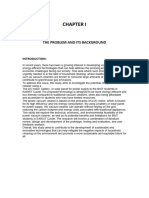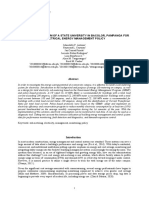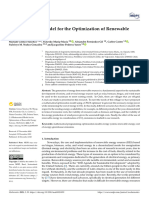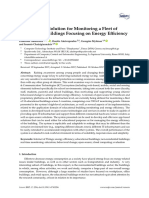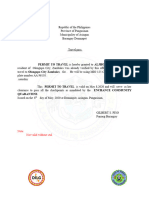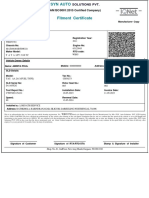SSRN Id3429842
SSRN Id3429842
Uploaded by
Ritchell Mae MalolotCopyright:
Available Formats
SSRN Id3429842
SSRN Id3429842
Uploaded by
Ritchell Mae MalolotOriginal Title
Copyright
Available Formats
Share this document
Did you find this document useful?
Is this content inappropriate?
Copyright:
Available Formats
SSRN Id3429842
SSRN Id3429842
Uploaded by
Ritchell Mae MalolotCopyright:
Available Formats
Energy Conservation System for Classroom using
Microcontroller: An Innovation
Alaina Thea A. Villanueva Anthony U. Concepcion
Bulacan State University Bulacan State University
Guinhawa, City of Malolos, Bulacan, 3000 Guinhawa, City of Malolos, Bulacan, 3000
alainathea.villanueva@bulsu.edu.ph anthony.concepcion@bulsu.edu.ph
+63928-136-3881 mobile number +63949-647-7689 mobile number
Abstract — Schools are now focusing on power saving As the world demand for energy rises, the concern
measures aimed at conserving energy, going green and saving for the natural resource has become vital. These natural
money. The main concept behind this study is to measure resources are in inadequate supply. Government and
electricity consumption and display the number of people entering concerned individuals are working to make use of
a classroom by counting through a system built in device.
renewable resources a priority, and to lessen the
When number of people inside the room is equal to zero, irresponsible use of natural supplies through increased
the power supply inside the room can be cut using a relay interface conservation.
and when the person’s count is greater than zero, the
microcontroller turns on the room lights and fans. By using this Using less energy has some benefits. It allows
device the school can conserve energy. By these, the schools can people, governments and businesses to save money, and it
benefit better foster student learning, increase knowledge, and lets power plants avoid costly upgrades. However, global
serve as centers of community life. In view of the foregoing issues warming has made energy efficiency a big issue in recent
and concerns pertaining to high energy consumptions, the use of
years and experts agree that reducing electrical usage results
Energy Conservation System for Classroom may be considered as
possible solution to the aforementioned issues.
in less carbon dioxide released into the atmosphere.
The system was found highly acceptable in terms of Through a commitment to a high performance,
functionality; reliability; usability; efficiency; portability. The school districts are discovering that smart energy choices
acceptability of Energy Conservation System for Classroom is not can create lasting benefits for students, communities, and
only strongly recommended to be used and adopted by the school the environment. Through this, the system contains
administration to reduce their energy consumption and reducing additional supporting information for design, renovation and
their energy bills but also to be available for use by other colleges retrofit projects. The primary resource for developing and
or schools.
implementing this study should be in a district or school
As a whole the researcher was found highly acceptable wide operations and maintenance program that focuses on
and was strongly recommended for adoption for further energy efficiency. Also, the objective of this study is to
improvement of the system in the field of industrial technology. provide organizational and technical information for
integrating energy and high-performance facility
Keywords— Conserving Energy; Microcontroller; Relay management into existing Operations & Maintenance
Interface; Student learning; Industrial Technology; Schools; (O&M) practices.
Classroom.
The development of Energy Conservation
I. INTRODUCTION System for Classroom is an example of
The demand for electricity is on the rise. As the innovation. Which smart predictive
world population increases and global industrialization informatics tools are needed to help make
continues at a rapid pace, the need for reliable electricity sense of ever increasing configuration of
grows. The number of new connections and general load data, and thereby aid in day-to-day
growth has continued at a rapid pace, in line with economic productivity as well as support instruction
growth. Not only has the demand for electricity increased goals of economic competitiveness this
with more and more people connecting to the electric grid, premise under the CHED Memorandum
but also the needs and demands of electricity customers Order No. 03 Series of 2015 where it is
have increased due to the extent of technology deployed in stated that Philippine higher education
the average household. institutions face critical and urgent
challenges in major fronts of the research
and development and extension (RDE)
Electronic copy available at: https://ssrn.com/abstract=3429842
enterprise. RDEs was supported in any of importance of conserving electricity by using or providing
the following six multidisciplinary and system that use different parts like microcontroller, sensors
trans-disciplinary research platform. One and power regulations which could be an eye-opening to
of the six multidisciplinary and trans- those beneficiaries for saving money also for conservation
disciplinary is developing Smart Analytics of energy.
and Engineering Innovations. This
research platform is aimed at fostering In 2011 a lot of companies now are still not aware
and enabling research that can help data of how can they conserve electricity and what means can it
users such as small to medium business cause to our environment. A solution to this problem lies in
enterprises, industry, local governments, tapping the potential of advanced lighting controls - the
legislators, policy makers, teachers, automatic light switch. Lighting management systems use a
students, individuals, families and other microprocessor to act as the programmable brain of a
stakeholders harness the potential of data facility's lighting system. Based on a preset schedule, it
in varying levels of complexity in order to turns the lights on or off in a number of zones throughout
make informed decisions. the facility. Properly applied, the use of this technology has
been documented at monitored installations to generate
Today, much electricity is consumed in schools. anywhere from a 10% to 35% energy savings.
With air conditioning units, computers, multimedia and
laboratory equipment, mobile phones, and laptops plugged III. CONCEPTUAL FRAMEWORK
in halls, offices and classrooms, energy saving programs
have become a massive challenge to the school The main objective of the study is to design and develop
administrator. Forgetting to turn off the electricity is one of an Energy Conservation System for Classroom, the
the major problems that cause high energy consumption in researcher adopted the IPO model, which stand for input,
many schools. Moreover, the high cost of electricity in the process and output.
Philippines takes its toll on large-scale power consumers
like schools. To make the establishment financially viable,
the cost is shared among students, thus, contributing to the
expensive price tag of education.
Nowadays, schools are focusing on power saving
measures aimed at conserving energy, going green and
saving money. The main concept behind this study is to
measure and display the number of people entering a
classroom by counting through a system built in the gadget.
When number of people inside the room is equal to zero, the
power supply inside the room can be cut using a relay
interface and when the person’s count is greater than zero,
the microcontroller turns on the room lights and fans. By
using this device the school can conserve energy. Beyond IV. REASEARCH METHODOLOGY
these, the schools can benefit better in fostering student
learning, increase knowledge, and serve as centers of This chapter presents the research methodology
community life. In view of the foregoing issues and that utilized in obtaining, analyzing and interpreting the data
concerns pertaining to high energy consumptions, the use of requirements of the study. Included in this section are
Energy Conservation System for Classroom may be methods and techniques used in conducting the study,
considered as possible solution to the aforementioned population and sample of the study, research instruments,
issues. data collection procedure, and data processing and statistical
treatment in developing Energy Conservation System for
II. REVIEW OF RELATED LITERATURE Classroom.
This chapter presents the literature and studies after Research Design
the thorough and in-depth search done by the researcher. A
number of published and unpublished theses were also Methods and Techniques of the Study
examined and reviewed which helped provide directions in
preparing the basic framework of the research. The study utilized the developmental or action
research method in developing Energy Conservation System
The significance of the related literature used is to for Classroom. The focus on the procedures and processes
be aware and helped this study what would be the
Electronic copy available at: https://ssrn.com/abstract=3429842
involved analysis, development and evaluation of Energy researcher summarized the conclusions based on the five (5)
Conservation System for Classroom. categories of the acceptability of the system.
The descriptive method of research present and Data Processing and Statistical Treatment
describe quantitative evaluation of the system, as it exists.
Descriptive research contributes much to the establishment The data gathered was processed by the researcher
of standard norms of conduct, behavior or performance, by using statistical mean procedures utilized in data
generalizations of principles. analysis. Weighted mean and standard deviation were
analyzed.
The research method used by the researcher is
descriptive development method of research. It is a process Data Gathering Procedure
used to develop and validate the system. Steps involved in
this method include the following: (1) studying research The instrument used in the form of survey forms
findings pertinent to the products; (2) developing the was handled out to the target respondents. The imminent
product based on the findings, (3) field testing of the results were studied and tallied. The interview that was
product, and (4) revising the product. conducted with the respondents was gathered for data as
well. And observation became the basis for the
Population and Sample of the Study interpretation of data gathering through surveys.
Statistical Treatment of Data
The respondents of this study consisted of five (5)
competent person in the field of Industrial Technology: (1) a The statistical tools were determined the
computer programmer at Save22 Company Pasig city, effectiveness of the proposed utility. The following
Philippines, (1) Quality Control Engineer at Freyssinet statistical tools were used in the analysis and interpretation
Filipinas Corporation; (1) Software Engineer at Accenture of data.
Philippines; (1) Assistant Store Manager at Starbucks
Marilao; and (1) Graphic Designer at 7th Media Digital. V. PRESENTATION, INTERPRETATION AND ANALYSIS
OF DATA
Research Instrument
This chapter presents, analyzes and interprets the
The research instrument used for determining the data relative to the designing, developing, and validation of
acceptability of the device is an adaptation of an ISO 9126. the Energy Conservation System for Classroom. This chapter
Through the instrument was originally intended for the presents the discussions of the answers to the following
evaluation of software, same items were modified by the objective of the study on how an Energy Conservation System
researcher to suit it for the present project. for Classroom was developed for electrical power
consumptions.
The instrument was composed of several criteria
namely: functionality, reliability, usability, efficiency and Part I. The Design and Development of an Energy
portability. Conservation System for Classroom
A five point Likert was the basis for determining Planning. This phase is the foundation of all the
the numeric evaluation of the device. phases of any system development design. Planning,
analyzing and needs assessment is very important in system
Data Collection Procedure development. The researcher focused in defining clearly the
requirements of the system. Using detailed requirements
After the development of the Energy Conservation analysis the researcher produced a user – oriented
System for Classroom, the researcher asked the help of the description particularly the specification of the system,
professors and professional system developer in the field of which includes identification of for whom the system is to
Industrial Technology to evaluate Energy Conservation System be developed, the environment in which it will be used, the
for Classroom and to determine the acceptability as a constraints which it will be developed, objectives and the
technical tool. The five competent person in the field of assessment that will be used. After considering the
Industrial Technology; (1) a computer programmer at specification of the system the researcher planned and
Save22 Company Pasig city, Philippines, (1) Quality analyzed the problem and conducted a study to assess the
Control Engineer at Freyssinet Filipinas Corporation; (1) overall requirements needed in the development of an
Software Engineer at Accenture Philippines; (1) Assistant Energy Conservation System for Classroom.
Store Manager at Starbucks Marilao; and (1) Graphic
Designer at 7th Media Digital. After the evaluation, the Design Phase. The primary objective of design
phase is to identify user requirements and to build a system
that satisfies these requirements. During systems design, the
Electronic copy available at: https://ssrn.com/abstract=3429842
researcher identifies all necessary inputs, interfaces, management system was accurately translated to operating
processes and output. It is the systematic and specific procedures, and then to rectify any flaws in the solutions
process of identifying set of strategies aimed at attaining a that were then uncovered.
particular goal containing elements attaining to precise Evaluation and Revision Phase. It is the systematic
details. process that determines the quality of the final product. It is
Energy Conservation System for Classroom is designed an ongoing activity conducted at each phase that is used to
to detect people entering and leaving the room to turn on determine whether the objectives have been met and to
and turn off the classroom electricity. In every person identify those parts where modifications are required. The
entering and leaving the room, the system is equipped with last phase requires that the new system developed will be
an Arduino Microwave that reads the digital input from two tested to determine the weakness for modification.
receivers and calculates the number of persons inside the Evaluation should be done throughout the entire system
room, and then displays it on the Liquid Crystal Display design stage and even after implementation to identify the
(LCD). When the person’s count is greater than or equal to areas that still need revision.
one, the microcontroller turns on the room lights and fans
and when the person’s count is zero, it turns off all the lights Part II. The Required Components to Implement the
and fans as explained in the flowchart shown in System
Figure1below.
Type of sensors. This study used Ultrasonic Sensor
a type of Infrared Sensor (IR) which is used to detect the
presence of people by sending out ultrasonic waves into a
space and measuring the speed at which they return. Also
the study used a sensor that are highly suitable for detecting
motions. Ultrasonic sensors was used for a higher sensitivity
of detecting movements and that are highly suitable for
spaces. Examples of such spaces include restrooms, open
offices, classrooms and stairways, etc. space where a higher
degree of detection is desirable.
Figure 1. System flowchart of Energy Conservation
System for Classroom Figure 2. Ultrasonic Sensor (www.Mtechlog.com)
The system also has a transmitter side; a regulated Microcontroller system. Most electronic
DC power drives the entire transmitting circuit wherein devices that we use today have a Microcontroller in them of
different sensors like Infra-Red (IR) and PIR temperature some form or another. To control the system Arduino
sensors are attached to the microcontroller. Microcontroller was used as the “brain” of the Automated
Classroom Energy Management System. Like any other
Fabrication Phase. This phase elaborates and computer Microcontroller have input ports to easily detect
builds on the system objectives that were produced in the actions by a user, and output ports through which it
design phase. It is a process of successive refinement in expresses the results of its program. A lot of other devices
which the requirements are translated into computer such as lights, heat, or motion sensors, motors, our sound
programs and hardware requirements depending on the devices, are attached to these pins to allow the
system to be produced. Microcontroller to be sensitive to the world and to express
itself.
Assembly and Mounting Phase. It is the process of
putting the system into operation. It involves testing to
verify that the system works properly. After the system has
been developed, it must be tested thoroughly. Testing refers
to the evaluation of program and the system execution.
The researcher verified if the system works as
intended. The researcher conducted testing activities to
make sure that the automated classroom energy
Electronic copy available at: https://ssrn.com/abstract=3429842
Figure 3. Arduino atMega328p microcontroller
(www.arduino.com) Part III. The Cost Analysis of Power Consumption of the
Electrical interface. The Electrical Interface Developed Energy Conservation System for Classroom.
electrically connects the different devices that supports the
Automated Classroom Energy Management System. The To identify if the system is acceptable the
schematic design of the system is shown in Figure 4. researcher conduct a cost analysis installed a Sub-Meter in a
classroom to measure the consumed kilowatts of a regular
The program is loaded in the microcontroller lecture room with and without using the system.
that indicates all the designed input, process and output.
Power supply is automatically turned on when it receives Table 1 presents the comparative cost of
desired voltage and everything starts to happen at high electrical consumption in a month with or without the use of
speed. The control logic unit keeps everything under the device
control. It disables all other circuits to operate. While the
preparations are in progress. All the wires connected are Table 1
being filled with bits reflecting the state of all circuits within Electrical Consumption per Month
the microcontroller. All pins are configured as inputs. The
overall electronics starts operation in rhythm with pulse
Time Sub- Comput Mont
sequence.
Frame Meter ation hly
A measured (base on Cost
Entry Exit
C the
Senso Sens
A So Meralco
r or
C ur Gneratio
So ce n
ur 22 charge)
ce 0 Without January 16, 20.950 20.950 * Php
22 V the use 2017 – kw/h 4.9014 102.6
0 A The of February16, 8
V re device 2017
C is/a
A re
C DC
Vol
tag Per
0 With
the use
February
16, 2017 –
17.750
kw/h
17.750 *
4.9014
Php
86.99
of March 16,
e son
Figure 4. Block Diagram of Energy Conservation s System device 2017
Reg Insi Difference in monthly consumption ( with and Php
for Classroom. de
ulat without device) 15.69
or
From now on the time is measured in micro and
nanoseconds. Program counter is set to zero. Instruction Without the use of the device the consumption
from that address is sent to instruction decoder which from the previous month in kilowatt per hour is 20.950
recognizes it, after which is executed with immediate effect. multiply by 4.9014 which is the meralco generation charge.
The value program counter is incremented by 1 or it can be The researcher found out that the monthly cost is Php
decremented by 1 in opposite, and the whole process is 102.68.
repeated million times per second. With the use of the device the consumption
from the previous month in kilowatt per hour is 17.750
Power regulation. To give energy needed for multiply by 4.9014 which is the meralco generation charge.
the system a power supply is used to directly give The researcher found out that the monthly cost is Php 86.99.
availability of power only from the source with
inappropriate electrical characteristics by alternating current The difference in monthly consumption with or
(AC) instead of direct current (DC), also it is used to alter without the use of the device is Php 15.69. The researcher
the power to meet the device requirements. Digital devices found out that the use of Automated Classroom Energy
are so numerous, run on fairly high voltage AC, power Management System has difference in consuming electricity
supplies commonly change AC to DC raise and lower the in the classroom compared without using the
voltage as required. It is used to condition power and system.
protects against power source failures that might damage the
device.
Electronic copy available at: https://ssrn.com/abstract=3429842
Table 2 present the Comparative of Annual The evaluation results and acceptability of
Projected Cost of Electrical consumption with / or without the Energy Conservation System for Classroom was
the use of the device examined in terms of file criteria: functionality, reliability,
usability, efficiency and portability.
Table 2 Table 3
Annual Project Cost of Electrical Consumption Summary of User Acceptability of the System.
Criteria Mean Interpretation
Time Sub- Compu Mont Projected
Functionality 4.68 Highly Acceptable
Frame Met tation hly Annual
Reliability 4.80 Highly Acceptable
er (base Cost Cost
Usability 4.65 Highly Acceptable
mea on the (monthly
sure Meralc cost x 12) Efficiency 4.80 Highly Acceptable
d in o Portability 4.75 Highly Acceptable
a Gnerati Highly
Overall Mean 4.73
mon on Acceptable
th charge)
With January 20.9 20.950 Php 1,232.16 The Energy Conservation System for Classroom as
out 16, 2017 – 50 * 102.68 a whole was found Highly Acceptable as shown by the
the January kw/h 4.9014 grand mean of 4.73 and was strongly recommended for
use of 15, 2018 adoption for further improvement of the system, the flowing
devic suggestion/comments were given by the experts.
e
With February 17.7 17.750 Php 1, 043.88 VI. SUMMARY, CONCLUSION AND RECOMMENDATION
the 16, 2017 – 50 * 86.99
use of February kw/h 4.9014 This chapter presents the summary of results, the
devic 15, 2018 conclusions drawn, and there approvals offered by the
e respondents. This study was to regulate the effect of
Difference in annual consumption ( with and 188.28 advertising alcohol on young people. Questionnaires were
without device) ran out to gather required data to accomplish and outline the
study.
Without the use of the device the monthly Summary
consumption in kilowatt per hour is 20.950 multiply by
4.9014 which is the meralco generation charge. The 1. Today, substantial amount of electricity is consumed in
monthly cost is Php 102.68 multiply by 12; the researcher schools. With air conditioning units, computers,
found out that the annual projected cost of electrical multimedia and lab equipment, mobile phones, and
consumption is Php 1, 232.16. laptops plugged in halls, offices, and classrooms,
energy saving programs have become a massive
With the use of the device the monthly challenge to the school administrator. Majority in
consumption in kilowatt per hour is 17.750 multiply by schools, their problems are forgetting to turn off the
4.9014 which is the meralco generation charge. The electricity that causes high energy consumptions.
monthly cost is Php 86.99 multiply by 12; the researcher Energy Conservation System for Classroom help
found out that the annual projected cost is Php 1,043.88. schools by managing the energy in each classroom.
Also the main target of the developed system was to
The difference in annual projected cost conserve energy by which schools is allocating large
consumption with or without the use of the device is Php amount of money in energy consumption in paying
188.28. The researcher found out that the projected annual electric bill. Conservation can slow the effect of climate
cost consumption with the use of Automated Classroom change, reducing the occurrence of disastrous weather
Energy Management System has difference in consuming events. Beyond the basic goal of conserving the
electricity in the classroom compared without using the planet’s resources, conservation has economic, political
system. and cultural benefits. Conservation is personally
empowering as well. Every students and citizens can
Part IV. Evaluation results and acceptability of the takes steps to conserve energy, and a unified effort can
Energy Conservation System for Classroom as a result in significant, positive results.
technical tool.
Electronic copy available at: https://ssrn.com/abstract=3429842
The main concern of the study was to design and properly designed and selected to appropriate by
develop Automated Energy Management System for function as designed.
electrical power consumptions and to help the school in
conserving energy. 3. Energy Conservation System for Classroom is deemed
highly acceptable system by proposed end users as
2. The researcher believes that Energy Conservation evaluated by the pool judgment of five competent
System for Classroom can contribute in enhancing to persons in the field of industrial management; (1) a
reduce the power consumptions of the school. The computer programmer at Save22 Company Pasig city,
integration of ultrasonic sensor a type of infrared sensor Philippines, (1) Quality Control Engineer at Freyssinet
(IR), Arduino microcontroller, electrical interface, and Filipinas Corporation; (1) Software Engineer at
power regulation to make the system functionality to Accenture Philippines; (1) Assistant Store Manager at
further enhance in conservation of energy power. Starbucks Marilao; and (1) Graphic Designer at 7th
Media Digital.
3. The study utilized the developmental or action research
method in developing Energy Conservation System for Recommendations
Classroom. The focus was on the procedures and
processes involved analysis, development and Based on the findings and conclusions, the following
evaluation of Energy Conservation System for recommendations are presented.
Classroom. The examination was done through the pool
judgment of five competent persons in the field of 1. It is strongly recommended that schools should
industrial management; (1) a computer programmer at consider the installation of the Energy Conservation
Save22 Company Pasig city, Philippines, (1) Quality System for Classroom in classrooms in order to
Control Engineer at Freyssinet Filipinas Corporation; minimize electric consumption thus, reducing operating
(1) Software Engineer at Accenture Philippines; (1) costs.
Assistant Store Manager at Starbucks Marilao; and (1)
Graphic Designer at 7th Media Digital. 2. To properly operate the system, users are advised to
properly position the sensors to accurately detect the
4. To determine evaluation results and acceptability of the ingress and egress of individuals monitored by the
Energy Conservation System for Classroom was system.
examined in terms of five (5) criteria: functionality,
reliability, usability, efficiency and portability. 3. It is recommended that the Energy Conservation
The acceptability of the Energy Conservation System System for Classroom be installed in a two door lecture
for Classroom was assessed in five dimensions based room to have an accurate of the system in of detecting
on the Likert scale: 4.51 – 5.0 Highly Acceptable, 3.51 people who entering and leaving the class room.
– 4.50 Very Acceptable, 2.51 – 3.50 Acceptable, 1.51 –
2.50 Moderately Acceptable, and 1.0 – 1.50 4. Future researchers may use this study as baseline data
Unacceptable. in further improving the device.
Conclusions VII. REFERENCES
Base on the finding of the study, the following A. Books
conclusions were drawn: [1] Alvarez, R. (2010). How to Connect a Voltage Regulator
in a Circuit. Telecommunication weekly. p.472
1. The Energy Conservation System for Classroom has the [2] Bartunek, H., Cerny, M. (2014). Dual Beam Sensor and
advantages that improve in reducing electrical power Edge Detection System and Method. Oxford
consumptions. Advantages are: (a) automatically turn- Review of Education, 38 (1). pp. 9-24. ISSN 0305-
off electricity when the counter turns zero, (b) can be 4985.
installed in any single door rooms, and (c) it can also [3] Delaney, D., O’Hare, G., Ruzelli, A. (2014). Evaluation
identify how many persons are inside the classroom. of Energy – Efficiency in Lighting Systems using
The system may also help the Schools to reduce their Sensors Networks. Workshop on Embedded
energy bills; the school administration can use that Sensing Systems for Energy-Efficiency in Buildings
money for other purposes. pages 61-66.ISBN-978-1-60558-824-7
[4] Mills, R. (2013), Lights Off. Dairies Industries
2. The integration of all parts; The Ultrasonic Sensor a International, Bell Publishing Ltd. Vol. 71. pp. 22-
type of Infrared Sensor (IR), Arduino Microcontroller, 23. July 2013
Electrical Interface, and Power Regulation have been B. Publication
Electronic copy available at: https://ssrn.com/abstract=3429842
[5] DiLouie, C. (2011). Automated Controls can Save
Energy. Facilities Design & Management. Vol. 14.
p. 35. ISSN 02794438
[6] Sven337 (2014). Automatic and Lighting in the
Bathroom Using a Motion Sensor. Published
Article https:// perso.aquilenet.fr /~sven337
/english/ 2014/03/30/
Automatic_lighting_in_bathroom.html
[7] Vieira, M. A .M, Coelho, C. N. (2013). Survey on
Wireless Sensor on Network Devices.
http://ieeexplore.ieee.org/document/1247753
[8] Wang, C. P. (2012). Performance of a Laser Beam Wave
Front Sensor. A new Technique. Applied
Optics Vol.23, Issue 9, pp. 1399-1402, 2012.
[9] Wladawski, I. (2013). Managing Complex innovation.
Retrieved from February 11, 2013 from http: //
blog. irvingwb.com / blog / 2013/ 02 /managing-
complex-disruptive-innovations-some-lessons-
learned.html
Published Theses
[10] Martirano, L., (2011), Environment and Electrical
Engineering (EEEIC), 2011 10th International
Conference on Lighting systems to save energy in
educational classrooms.
C. Electronic References
[11] Gionet, D., Wikkerink, L., Nguyen, H. V. (2015).
Automatic Door Safety System.
https://www.google.com/patents/US4914859
[12] Malik, B. (2015). Advanced RISC Machines (ARM)
Microcontroller.
http://microcontrollerslab.com/arm-
microcontroller/
D. Other Sources
[13] Ched Memorandum Order No. 03 (Series of 2015).
“Policy Reforms for the Grants-In-Aid Funds of
the Commission on Higher Education (CHED) for
Research and Development, and Extension”
Electronic copy available at: https://ssrn.com/abstract=3429842
You might also like
- PHD Thesis On Energy AuditDocument5 pagesPHD Thesis On Energy Auditexuhszief100% (2)
- Economic Analysis Styrene Production ProcessesDocument4 pagesEconomic Analysis Styrene Production ProcessesfdfNo ratings yet
- Energy Conservation Thesis PDFDocument7 pagesEnergy Conservation Thesis PDFsew0m0muzyz3100% (2)
- Energy Efficiency Program For Power Availability in Research InstitutionsDocument13 pagesEnergy Efficiency Program For Power Availability in Research InstitutionsSAMPSON BENDORNo ratings yet
- Electricity Consumption ThesisDocument5 pagesElectricity Consumption Thesisfczeohief100% (2)
- Chapter 1 1.1 General Introduction Energy Expenditures Pose An AnnualDocument55 pagesChapter 1 1.1 General Introduction Energy Expenditures Pose An AnnualcorpuzryanNo ratings yet
- Innovation On Energy ConservationDocument94 pagesInnovation On Energy Conservationss.iamshiveshNo ratings yet
- Energy Audit in MadonnaUniversity NigeriaDocument6 pagesEnergy Audit in MadonnaUniversity NigeriaNaMatazuNo ratings yet
- Energy Optimization Prediction Write UpDocument44 pagesEnergy Optimization Prediction Write UpfcbolarinNo ratings yet
- Ee-Dhvsu Property: Submetering System For A State University in PampangaDocument6 pagesEe-Dhvsu Property: Submetering System For A State University in PampangaJohn Paulo AntonioNo ratings yet
- Motion Activated Temperature Controlled Matc Electric FanDocument5 pagesMotion Activated Temperature Controlled Matc Electric FanBuena QuintinNo ratings yet
- E-STEM ProjectDocument9 pagesE-STEM Projectsamanisbest553No ratings yet
- Energy Consumption in Nigerian Istitution Covenent UniversityDocument9 pagesEnergy Consumption in Nigerian Istitution Covenent UniversityNaMatazuNo ratings yet
- Abdul Wahab 2020 J. Phys. Conf. Ser. 1529 052022Document10 pagesAbdul Wahab 2020 J. Phys. Conf. Ser. 1529 052022Azue RamliNo ratings yet
- Beige and Green Illustrative Clean Energy PresentationDocument10 pagesBeige and Green Illustrative Clean Energy Presentationdiana.diaz5423No ratings yet
- Educ Green Data Center WPDocument17 pagesEduc Green Data Center WPJamile Katiuska García ZarcosNo ratings yet
- Data Warehouse Structure For Energy Monitoring System Towards Campus SustainabilityDocument5 pagesData Warehouse Structure For Energy Monitoring System Towards Campus SustainabilityEditor IJTSRDNo ratings yet
- Energy Management Thesis PDFDocument6 pagesEnergy Management Thesis PDFNeedHelpWritingMyPaperCleveland100% (2)
- Cse k12 Ebook Fall2023Document57 pagesCse k12 Ebook Fall2023kirmaniNo ratings yet
- Chapter 1Document5 pagesChapter 1lowelldopeNo ratings yet
- Artigo - Aula 15Document24 pagesArtigo - Aula 15ALEXANDRE SALES BRAZ JUNIORNo ratings yet
- Literature Review On Energy Saving SystemDocument6 pagesLiterature Review On Energy Saving Systemc5pnmx9f100% (1)
- Towards Designing and Developing Curriculum For The Challenges of The Smart Grid EducationDocument8 pagesTowards Designing and Developing Curriculum For The Challenges of The Smart Grid EducationkalokosNo ratings yet
- draft-SIGNIFICANCE OF THE STUDYDocument5 pagesdraft-SIGNIFICANCE OF THE STUDYjustsoarermoonNo ratings yet
- A Research On Electrical Energy Audit in An Educational Institution - A Case StudyDocument6 pagesA Research On Electrical Energy Audit in An Educational Institution - A Case Studyevangeline.llanitaNo ratings yet
- Submetering System of A State University in Bacolor, Pampanga For Electrical Energy Management PolicyDocument12 pagesSubmetering System of A State University in Bacolor, Pampanga For Electrical Energy Management PolicyJohn Paulo AntonioNo ratings yet
- Academic Building Energy Conservation Opportunities, Ferdinand g. Manegdeg, 2015Document18 pagesAcademic Building Energy Conservation Opportunities, Ferdinand g. Manegdeg, 2015docwit10No ratings yet
- Molina Solana2017Document12 pagesMolina Solana2017Ferdaws BNasr BSalahNo ratings yet
- Teaching Renewable Energy System Design and Analysis With HOMERDocument13 pagesTeaching Renewable Energy System Design and Analysis With HOMERel_ruso__83No ratings yet
- Eumind Chatgpt QuestionsDocument4 pagesEumind Chatgpt Questionsapi-724176609No ratings yet
- Research Paper On Energy Conservation PDFDocument6 pagesResearch Paper On Energy Conservation PDFvvjrpsbnd100% (1)
- Chapter 1&3 - 5Document20 pagesChapter 1&3 - 5gwapoako9999999 999999No ratings yet
- University SustainabilityDocument4 pagesUniversity SustainabilityDarmanto Suwarni MunirNo ratings yet
- A Review of Ubicomp For Renewable Energy: Stanley Adiele OkolieDocument3 pagesA Review of Ubicomp For Renewable Energy: Stanley Adiele OkolieUbiquitous Computing and Communication JournalNo ratings yet
- Microgrid Policy Review of Selected Major Countries, Regions, and OrganizationsDocument34 pagesMicrogrid Policy Review of Selected Major Countries, Regions, and OrganizationsAlessandro Harry LaterzaNo ratings yet
- Mathematics 09 00039 v3Document16 pagesMathematics 09 00039 v3Yash BaghelNo ratings yet
- Energies: Smart Home Energy ManagementDocument5 pagesEnergies: Smart Home Energy ManagementVIKRAM K 14PHD0358No ratings yet
- Switching ActionsDocument17 pagesSwitching ActionsRafin সাজ্জাদNo ratings yet
- BMS Design and IOTDocument16 pagesBMS Design and IOTallanotwori4No ratings yet
- MZF-EY-AB Rev2 Clean VersionDocument40 pagesMZF-EY-AB Rev2 Clean VersionryanNo ratings yet
- Research Paper On Sustainable EnergyDocument6 pagesResearch Paper On Sustainable Energyaflboetbe100% (1)
- Eapp Group 3 Concept PaperDocument23 pagesEapp Group 3 Concept PaperRhea CayabyabNo ratings yet
- Motion Sensor As Greening TechnologyDocument5 pagesMotion Sensor As Greening Technologyderrick owinoNo ratings yet
- Synthesis Report On Smart Home TechnologiesDocument4 pagesSynthesis Report On Smart Home TechnologiesSeth RathanakNo ratings yet
- ADVANCING DATA CENTER SUSTAINABILITY: Through Artificial Intelligence and Renewable Biological Power SourcesFrom EverandADVANCING DATA CENTER SUSTAINABILITY: Through Artificial Intelligence and Renewable Biological Power SourcesNo ratings yet
- Solarcase StudyDocument8 pagesSolarcase StudyVanz SanchezNo ratings yet
- Optimizing The Energy Saving Potential of Public Hospital Through A Systematic Approach For Green Building Certification in MalaysiaDocument14 pagesOptimizing The Energy Saving Potential of Public Hospital Through A Systematic Approach For Green Building Certification in MalaysiaChen Siang LooNo ratings yet
- Energy Efficiency Innovative I To 12Document405 pagesEnergy Efficiency Innovative I To 12glassyglassNo ratings yet
- Optimizing Sustainable Energy Implementation of An Innovative Hydroelectric Generator SystemDocument26 pagesOptimizing Sustainable Energy Implementation of An Innovative Hydroelectric Generator SystemrobertoesnyrNo ratings yet
- Syllabus M Tech Green Energy Technology 2022 23Document60 pagesSyllabus M Tech Green Energy Technology 2022 23Beemkumar NNo ratings yet
- Energy Patrol Program: A Solution Towards Energy Conservation and Efficiency and Electrical Safety in Marcela T. Mabanta Memorial National HighschoolDocument19 pagesEnergy Patrol Program: A Solution Towards Energy Conservation and Efficiency and Electrical Safety in Marcela T. Mabanta Memorial National HighschoolMaria AngelicaNo ratings yet
- P.L.Shroff College of Arts & Commerce, Chinchani. Tal: Dahanu, Dist:palghar.401503Document41 pagesP.L.Shroff College of Arts & Commerce, Chinchani. Tal: Dahanu, Dist:palghar.401503Aayush sharmaNo ratings yet
- Analysis of The Newly Established Energy Engineering Course in Higher EducationDocument6 pagesAnalysis of The Newly Established Energy Engineering Course in Higher Education03J 17No ratings yet
- Harnessing Wind Power As An Alternative in Energy Consumption in Taysan High School and Child Development CenterDocument10 pagesHarnessing Wind Power As An Alternative in Energy Consumption in Taysan High School and Child Development CenterDaval LontocNo ratings yet
- Checked CHAPTER 1 - HybridDocument9 pagesChecked CHAPTER 1 - HybridHarry Francisco VillanuevaNo ratings yet
- 1 s2.0 S2666546820300434 MainDocument9 pages1 s2.0 S2666546820300434 MainDejene DagimeNo ratings yet
- Project Study Phase 1Document2 pagesProject Study Phase 1Evelyn Madrid100% (1)
- SYSTEM DYNAMIC STIMULATION MODEL FOR ENERGY UTILIZATIONDocument13 pagesSYSTEM DYNAMIC STIMULATION MODEL FOR ENERGY UTILIZATIONSamuel OluyemiNo ratings yet
- GSDC 05 Measurement and ControlDocument50 pagesGSDC 05 Measurement and Controlxuyen tranNo ratings yet
- ICREST Poster v1.3Document1 pageICREST Poster v1.3raisrulezNo ratings yet
- 4 - Wood JoineryDocument5 pages4 - Wood JoineryRitchell Mae MalolotNo ratings yet
- CagaananDocument11 pagesCagaananRitchell Mae MalolotNo ratings yet
- 1aban Et AlDocument24 pages1aban Et AlRitchell Mae MalolotNo ratings yet
- Leopoldo Thesis Chapter 1Document5 pagesLeopoldo Thesis Chapter 1Ritchell Mae MalolotNo ratings yet
- APPGCET - 2021 Post Graduation Admissions (Conducting by Yogi Vemana University, Kadapa and APSCHE)Document1 pageAPPGCET - 2021 Post Graduation Admissions (Conducting by Yogi Vemana University, Kadapa and APSCHE)Santosh PedireddiNo ratings yet
- Wind PowerDocument1 pageWind PowerBianca Pauline Tiatco VillagomezNo ratings yet
- CertificationsDocument60 pagesCertificationsdindincasioNo ratings yet
- CONFIRMATORY FACTOR ANALYSIS - Timo SaloviitaDocument8 pagesCONFIRMATORY FACTOR ANALYSIS - Timo SaloviitaasmaaNo ratings yet
- B 3 D 3 B 5Document16 pagesB 3 D 3 B 5Fausto Tito100% (1)
- lm833 Rev2 PDFDocument8 pageslm833 Rev2 PDFPhong DoNo ratings yet
- Electrochemistry ECAFM Research Solutions - DS097-RevA0Document2 pagesElectrochemistry ECAFM Research Solutions - DS097-RevA0Fabien CazesNo ratings yet
- Form Maintenance-Checklist DailyDocument15 pagesForm Maintenance-Checklist DailyRomly MechNo ratings yet
- Harsh MariwalaDocument3 pagesHarsh MariwalaKetki NavaleNo ratings yet
- The Role of Game Engines in Game Development and TDocument26 pagesThe Role of Game Engines in Game Development and Tsrs.2500shewaleNo ratings yet
- Heritage Institute of Technology Kolkata: Will BeDocument2 pagesHeritage Institute of Technology Kolkata: Will Beabhishek kumarNo ratings yet
- Lecture 1.0 IntroductionDocument61 pagesLecture 1.0 Introductionmd.niloy26643No ratings yet
- Stanford University - Graduate School of BusinessDocument1 pageStanford University - Graduate School of BusinessMatt RobertsNo ratings yet
- Vdocument - in - Ship Security Plan Web View Ship Security Plan For MV Aoekarla Prepared byDocument114 pagesVdocument - in - Ship Security Plan Web View Ship Security Plan For MV Aoekarla Prepared byEge SertNo ratings yet
- PILZ-PNOZelog Technical CatalogueDocument130 pagesPILZ-PNOZelog Technical CatalogueJorge_Andril_5370100% (1)
- South Asia in The World PoliticsDocument477 pagesSouth Asia in The World Politicsroijen_pkNo ratings yet
- DS MCW406 128G DatasheetDocument5 pagesDS MCW406 128G DatasheetsistemasNo ratings yet
- Company Profile PT. Berca Hardayaperkasa MSI.R3Document15 pagesCompany Profile PT. Berca Hardayaperkasa MSI.R3Daniel Kristanto SandjojoNo ratings yet
- Learning Task 8 Marabi LynethDocument3 pagesLearning Task 8 Marabi LynethLOVELY MAE FANTILANANNo ratings yet
- Morton Pierce Affidavit in BofA-Merrill CaseDocument18 pagesMorton Pierce Affidavit in BofA-Merrill CaseDealBookNo ratings yet
- Openswitch Opx Install Guide r221Document10 pagesOpenswitch Opx Install Guide r221Ahmad WahidNo ratings yet
- Coatings Products List by Specification CustodianDocument18 pagesCoatings Products List by Specification CustodianMuluken TesfayeNo ratings yet
- WB853783Document1 pageWB853783Pawan KumarNo ratings yet
- A MatlabSimulink Model For Capacitor Voltages Balancing inDocument6 pagesA MatlabSimulink Model For Capacitor Voltages Balancing inSudip MondalNo ratings yet
- CS10-8L: Computer Programming Laboratory Machine Problem #3: Variables, Input and OutputDocument4 pagesCS10-8L: Computer Programming Laboratory Machine Problem #3: Variables, Input and Outputjian cool dudeNo ratings yet
- Ductile Iron Castings: Standard Specification ForDocument6 pagesDuctile Iron Castings: Standard Specification ForLuis F. LoachamínNo ratings yet
- Solid Waste Management BudgetDocument43 pagesSolid Waste Management BudgetWilfredo Gabata SinoyNo ratings yet
- SAP BPC Embedded ArchitectureDocument30 pagesSAP BPC Embedded ArchitectureRamNo ratings yet
- EEFM PracticeDocument4 pagesEEFM PracticePhoenixRoboNo ratings yet



















